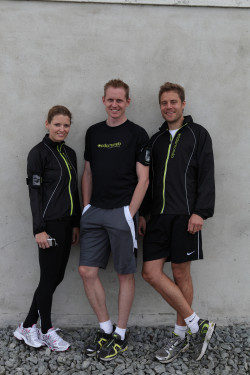The fact that I ran the last 400 metres in order to be on time for my meeting for the first Boost article was very appropriate, seeing as though I was on my way to sit down with Mette Lykke, CEO and Co-Founder of Endomondo, the app whose mission is to make fitness fun and turns your phone into a personal trainer and social fitness partner.
 I can certainly vouch for the suitability of Endomondo as a candidate for our Focus article series, as I have been a user for many years, long before I moved to Denmark. I clearly remember standing in my London flat four years ago, with my girlfriends father proudly showing off a Danish app which tracked your runs using GPS and allowed you to record and analyze your performance.
I can certainly vouch for the suitability of Endomondo as a candidate for our Focus article series, as I have been a user for many years, long before I moved to Denmark. I clearly remember standing in my London flat four years ago, with my girlfriends father proudly showing off a Danish app which tracked your runs using GPS and allowed you to record and analyze your performance.
When you look at the numbers, this is not as surprising as I initially thought it was, as the UK is in fact the third biggest market for Endomondo, after the US and Spain respectively.
The Danish market is actually the fifth largest in terms of users, but the first in terms of penetration, with around 1.5 million Danes having downloaded a version of the app. Denmark is the perfect place to prove the concept, as the nation is keen on exercising and Danes were early adopters of smartphones.
Today, Endomondo is a worldwide success, with a strategy plan for 20 countries on which they are focusing on, and have become Nike’s major competitor in the fitness tracking space, having passed over 20 million users in 2013.
“Nobody does marketing better than Nike, we have spent next to nothing on advertising, we got all of our users organically.”
But they didn’t always have it so good, and like everyone else the early days had plenty of lows, as well as highs. So where did it all begin for them?
Mette and her co-founders Christian and Jakob all met at Mckinsey before they set out to explore the idea of Endomondo together. They spent the first month working out of one of their apartments before moving to a small office in the city center for around a year before moving out to where they are now, a beautiful office with a fantastic view overlooking the water in Christianshavn.
They used savings to finance themselves in those early days, and Mette advises others to do the same, stating that everybody needs some sort of financial security around them.
“Even if you lose your savings, at least you would could say that you pursued your dream”

Despite the hard days, they never doubted themselves, and they always had the confidence to do more, and keep going. I asked Mette if there was a time when they doubted what they were doing, and she replied assertively, that without wanting to sound arrogant, they always knew they were onto something, it was just a matter of time as to when others would realize they were.
This demonstrates the belief and confidence that founders need to possess in order to succeed, and this statement was a telling insight into the drive behind Mette’s calm exterior.
Financial crisis, US adventure and business angels
They started the company in November 2007 and launched their first version in August 2008. Two weeks later, Lehmann brothers collapsed and the worlds financial landscape changed forever.
At this stage, they had been looking for investment for a while, and although this put a brief spanner in the works, they were eventually able to secure a round from business angels. All of these investors were Danish based, and proof that the popular myth of there being no money in Denmark is an exaggerated one.
“People often overlook business angels, but they are a good source of money to start things off, and if they are passionate can be extremely valuable”
The money was used for hiring and to support an exploration into the American market, including an office in San Francisco which they used for two years before shutting it down due to it not being cost effective.
Endomondo was almost before its time; when they started the app store didn’t exist and only the latest Nokia phones had GPS. They took a calculated risk that GPS would become mainstream, and when the second version iPhone had GPS, they knew their gamble was about to pay off.
However, the turning point was actually being featured by Blackberry, which bought flocks of UK and US users on board, and led to them opening dialogue with Google, which was another big stepping stone.
I asked whether they set out with a clear business model in mind.
“We figured that if users loved it and we got enough on board then we would come up with something, in all likelihood probably ads.”


In the end, they experimented with various monetization avenues, including a webshop and selling sportswear, but these never really took off, and now they have settled on something which does work, selling a pro version of the app, and offering premium accounts.
The pro version has proved to be a big success, with a double figure conversion rate from the free app, and while premium is not quite at that level yet, confidence is high that 2014 will see big progress.
The premium version is a B2C product, with a B2B version focusing on employee fitness and allowing companies to encourage employees to exercise. With 1 in 3 people in the Danish workforce already a user of Endomondo, things look extremely encouraging for the premium model succeeding.
With the business model now prospering, and the user-base continuing to grow, Endomondo look set to continue to dominate the fitness market both nationally and globally, and are doing an incredible job of boosting the reputation of Denmark’s startup scene.
 Nordic Startup News Early Stage Startup News From The Nordics
Nordic Startup News Early Stage Startup News From The Nordics


3 comments
Pingback: Vækstteamet fastslår: Digitalisering afgørende for DK | Trendsonline.dk
Pingback: Trendsonline launches the FOCUS series- Danish startup success stories : Øresund Startups
Pingback: Branson, Business Angels og hardcore erfaringsudveksling | Trendsonline.dk